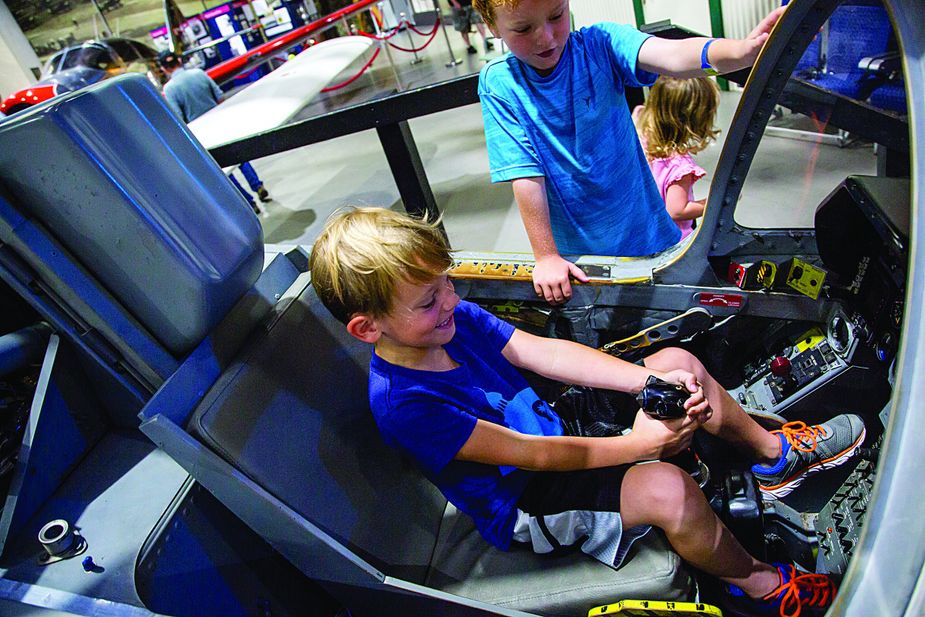Blast Off
Published May 2023
By Natalie Mikles | 7 min read
There's only one place in Oklahoma where kids and adults alike can tour a model of the International Space Station, take a spin in a space shuttle simulator, and feel what it was like to fly a P-51 Mustang like the famed Tuskegee Airmen.
Since it opened twenty-five years ago, the Tulsa Air and Space Museum has offered these hands-on exhibits and much more. It's all part of a mission to preserve Oklahoma's aerospace history and inspire science-based learning through discovery. And it’s that idea of discovery that draws visitors of all ages. Unlike some museums, the Tulsa Air and Space Museum’s interactive learning opportunities are not geared just toward children—they are intentionally created for all ages. After all, you’re never too old to sit in a cockpit and imagine the feeling and adrenaline of being a fighter pilot.
“It’s one thing to read something in a textbook but different to experience it,” says curator Alex London.
Preserving the memories and sharing the stories of Oklahoma’s aviation pioneers with visitors from across the state and beyond is paramount to the museum. London says many are surprised at the major role Oklahoma played in the early days of aviation innovation and what a powerhouse the state was in aviation manufacturing.
Though the museum’s story of flight begins with Tulsa’s first recorded aviation event—a smoke balloon flight in 1897-—it really built momentum thanks to the oil and gas industry.
“You had individuals looking for work, coming from the coasts,” London says. “The most efficient way to do so was through aviation travel. As a result, airplanes really took off, and more private and commercial aircraft came
to Oklahoma.”
In 1930, Tulsa’s Municipal Airport was the busiest airport in the world. Museum goers can walk through the original door frames of the facility, just as Wiley Post, Amelia Earhart, and Will Rogers once did.
Oklahoma’s role in the space race also is integral, as Tulsa Air and Space Museum visitors learn. For example, guests can discover all about Rockwell Aviation’s impact in helping to design the command module used in the Saturn V rocket in the 1960s.
The design of the Air and Space Museum is cavernous, with appropriately sky-high ceilings portraying the vastness of the cosmos and flight in the building itself. Groups of children on field trips often look up, mouths open, amazed as they pass below a Navy Bell helicopter, an aquatic landing plane, and a homemade gyrocopter.
It’s a place Jenks resident Candice Padley enjoys taking her second-grade son, who particularly is excited to see what he calls “the Top Gun plane.”
“It’s a great place for kids,” Padley says. “It’s something different—an opportunity for both learning and play.”

Kids can get a feel for the pilot's seat safely on the ground at the Tulsa Air and Space Museum complex. Photo by Lori Duckworth
Another visitor favorite is the planetarium, a full-dome experience featuring digital shows such as Faster Than Light, Black Holes, or Destination Mars curated by Planetarium Manager Bryan Kyle. Many visitors also come for the live star shows and other community events including the Runway Run 5K every March.
In 2022, museum staff installed a flight simulator, which was created by University of Tulsa engineering students in partnership with the museum and CymSTAR, a defense contractor and engineering company.
“With this, you can get inside and feel what it’s like to land a space shuttle,” London says.
New to the museum early this summer is a manned maneuvering unit, which also was developed with the help of TU students.
“It’s kind of like a space jetpack,” London says. “It’s a really great digital experience. You can sit on this MMU chair and go on a spacewalk yourself.”
The Tulsa Air and Space Museum also has a flight lab with full PC gaming units with Microsoft Flight Simulator. This technology is the closest feeling visitors can get, from yoke to throttle, to flying a real plane.
Amidst all the technological marvels and hands-on fun is the heart of the museum—the docents and speakers who love to talk Oklahoma aviation. London says visitors always can find someone to speak to or ask questions of, whether they want to do a deep dive into aerospace or just learn some fun fast facts.
“Last year, we had Oklahoma’s own John Herrington, a NASA astronaut who was part of the shuttle missions, come talk to folks and answer their questions,” London says. “And there are plenty of other Oklahomans who we may not know their names but were instrumental, in one way or another, in aviation history.”
Celebrating Oklahoma’s monumental aeronautic achievements while inspiring Okies young and old to space walk into the future: The Tulsa Air and Space Museum is a place where the possibilities are as infinite as the stars, the galaxies, as space itself.

.jpeg)





